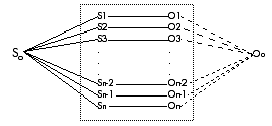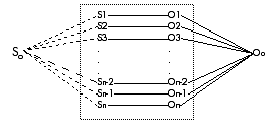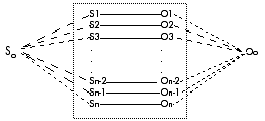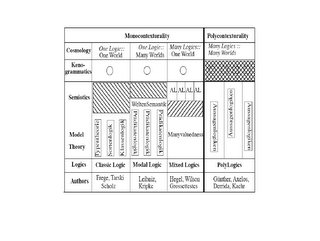A little typology
The little typology of writing paradigms is confronted with the "Diagrams of the 4 World-Models". The 4 world-models are modeling the 4 possible configurations between rationality and reality or logics and worlds. A correspondence between the 4 paradigms of writing and the 4 world-models may be established. Each subject is realizing the spirit/mind/speech/writing/reality relation, i.e., its reality/rationality or world/logic relation in a specific world model.
http://www.thinkartlab.com/pkl/media/SKIZZE-0.9.5-Prop-book.pdf
Phonologism of Western Writing
This is the scheme of a logocentric understanding of writing. It corresponds to the dominant tradition of Western philosophy and linguistics. But there are no surprises to observe that this scheme holds in a similar way in other cultures, too.
Aristotle, On Interpretation:
“Spoken words are the symbols of mental experience
and written words are the symbols of spoken words”.

Hegel writes in his Encyclopaedia of the Philosophical Sciences, Part III: The Philosophy of Spirit (1830)
"Alphabetic writing is on all accounts the more intelligent: in it the word ą the mode, peculiar to the intellect, of uttering its ideas most worthily ą is brought to consciousness and made an object of reflection." http://www.thinkartlab.com/CCR/2006/08/alphabetism_29.html
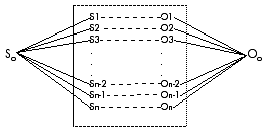
So: transcendental subject, Ultimate Universal Logic, not accessible to empirical subjects.
Oo: transcendental object, Ultimate Eternal Reality, not accessible to empirical subjects.
Si: empirical subjects.
Oi: empirical realities.
One sentence :: one meaning
Perfectly realized by normed alphabetism. Isomorphism between written sentence and its meaning. Sentences are thought as names of objects (entities). This is the position of realism and platonism.
Semantic truth condition (Tarski):
correspondence between meaning and reality.
Grammatology of Chinese Writing
This scheme corresponds to the Chinese understanding of writing as it is exposed by Liu Hsieh. There are similarities in the pre-Aristotelian tradition of Plato and Pythagoras to find. http://www.thinkartlab.com/CCR/2006/10/liu-hsiehs-grammatology.html
Gotthard Gunther
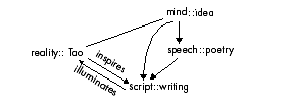
"That is, in holding to the ideograms, lies an unconscious insight of a massive asymmetry between spoken and written language. It is the written language, on which a main culture rests. It possesses an identity strength, which stands out clearly against the identity weakness of the spoken word." http://www.thinkartlab.com/CCR/2006/09/gnthers-asymmetry.html
Many sentences :: one meaning
Situation of the interpretation of Chinese hieroglyphs by negotiation. Hieroglyphs are unifying many sentences in one scriptural pattern. The hieroglyphs have a mediating function to the plurality of interpretative sentences. Such sentences are not isolated and unrelated to each other. The model of thinking is not dominated by the concept of sentences or names. But by the written hieroglyphs which have to be interpreted. Thus, this model is relational and focussed on the interplay between writing and speech. But this interplay between scriptural and interpretational activities is not yet itself inscribed (conceptualized and formalized). It is realized in practise of communication in the Lebenswelt.
Actional truth condition:
True, iff accepted by all negotional partners involved.
Graphematics of Chinese Writing
The graphematical model of writing is emphazing the practical aspect of schematic work in form of the computation by an abacus. This is in strict contrast to the still "logos" related writing of the grammatological model.
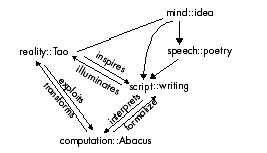 Hence, this scheme is considering the influence of technological and cultural practise on the paradigm of writing. The emphasis is on the influence of the usage of the Abacus on reality and on the concept of literal and algebraic writing. It is thought that the development of the concept of zero and the organizational system of positionality is an interpretation of the practice of the usage of the Abacus in calculations. Hence, techniques of computations have influenced the general structure of writing. Especially the invention of the concept and notation of zero.
Hence, this scheme is considering the influence of technological and cultural practise on the paradigm of writing. The emphasis is on the influence of the usage of the Abacus on reality and on the concept of literal and algebraic writing. It is thought that the development of the concept of zero and the organizational system of positionality is an interpretation of the practice of the usage of the Abacus in calculations. Hence, techniques of computations have influenced the general structure of writing. Especially the invention of the concept and notation of zero.http://www.thinkartlab.com/pkl/lola/Abacus.pdf
Polysemy of sentences solved by modal logic of alphabetism. Sentences are deliberated from their fixation to names. They have different meanings depending on different contexts which are themselves defined by sentences. Thus a kind of circularity is involved. This is the position of constructivism and relativism.
Model theoretic truth condition (Kripke):
True, iff true in all contexts.
Morphogrammatics and Polycontexturality
Proemiality of scriptural and hermeneutic procedures.
The mind is strongly embedded into reality. Reality is reflected by the minds activity of writing, speech and interaction. The mind is part of the technology of human activity. Human activity is embedded into reality.
http://www.thinkartlab.com/CCR/2006/10/blog-post_07.html
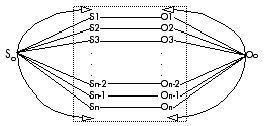 The hegemony of one world and one logic is destroyed and disseminated over a multitude of loci constituting a new world containing both, the rationality and the reality in it. The focus is on the distribution and mediation of the disseminated origins.
The hegemony of one world and one logic is destroyed and disseminated over a multitude of loci constituting a new world containing both, the rationality and the reality in it. The focus is on the distribution and mediation of the disseminated origins.The hegemony of the origins is rejected and destroyed. But the focus is on its rejection and destruction, i.e, on the autonomy of the different rationality/reality relations and not on their mediation and localization inside a new world model like in the constellation of rejection.
The structural properties of the fourth world model is principally different from the 3 other world models. In contrast to them, it can not be modeled by one and only one model. Its model is paradoxical, over-determined, ambiguous and dynamic.
World model IV has space to place the 3 other models of writing/meaning in itself.
http://www.thinkartlab.com/CCR/2006/10/semiotics-to-morphogrammatics.html
Many sentences :: many meanings
The plurality of sentences and meanings is not dispersed in isolated units but mediated to a compound structure of writing and interpretation. The interplay and chiasm between writing and meaning is primary. It is realized as interactional and reflectional activities between script and meaning on the base of a tabular conception of notational systems. This actional understanding of writing and meaning is dynamic, complex, open for its history and future.
http://www.thinkartlab.com/pkl/lola/Godel_Games-short.pdf
Labels: Chinese, hieroglyphs, world models, writing systems

